
views
Planning Your Book

Start with a vague idea of what you want to do. The word 'book' is vague and could be taken many different ways. Are you looking to write a novel? A comic book? A picture or story book for children or even adults? A manifesto on nihilism? If you are looking to make a book, chances are you'll already have some vague idea what you want to do. Books are most easily divided into two categories: Fiction and Non-Fiction. However there are many possible mediums you could go about either. Some books are highly visual, while others rely solely on the written word.

Read other books. Digesting the art of other people is an integral (and often underrated) step in creating your own. If you've settled on a medium or genre, you should dive into a few books you think represent the best traits of that style. Place attention not just on the surface content of the writer's work (like plot and character) but the ways in which he brings it about-- through figures-of-speech, metaphor or flashback. For instance, someone writing an existential tract may look into George Batailles or Albert Camus. A would-be fantasy writer may want to check out Michael Moorcock's Elric series. If you like a trick an author uses in a certain work, make a note of it. Great writers borrow techniques from one another all the time; plagiarism only occurs when specific information is copied without due credit.

Determine your goal audience. No work of art was ever truly created in a vacuum. Even if your book is only being written to be read by yourself or another person, considering what the experience of reading your book will be like is a necessary part of planning. If you plan on eventually sending this work to a publisher or professional distribution, consider what they might be looking for in new releases. If you're writing it for your child, for example, try to imagine what it would be like to have your story read to you at bedtime. Doing some research into things like demographics and bestsellers will help you if you're serious about making a break into the bigger world of writing.
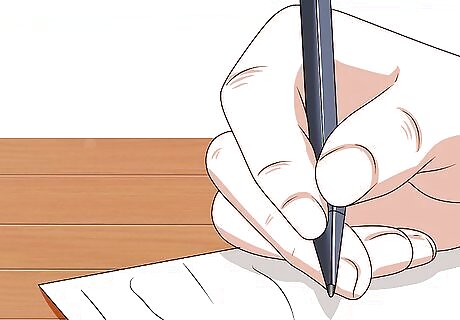
Try some freewriting. If you are feeling a case of writer's block, play around with freewriting exercises. Let your mind go wild with ideas, and don't worry too much about the way it looks as a finished product. Also, there aren't many writers out there who won't swear by the beneficial effects of mild alcohol or coffee consumption to get the creative juices flowing. Write using a train of thought. Get in touch with what you're thinking and write whatever pops into your head. Most of the time, you'll be able to trace a coherent sequence of ideas from it.

Acknowledge the work ethic involved in making a book. Before you get out of the ideation phase, it's important you stop and consider just how difficult it can be to make one a reality. Most projects that are started never see completion. This is usually due to the fact that real life concerns like work or relationship stress get in the way. What's more, you may lose inspiration quickly if the project's left idle for too long. Though the workload will depend on the type of book you're making, it's still a major commitment. Only try if you really think you're up to it.
Writing Your Book

Form a plot. You can't write a book without first having a clear idea of what you're writing on. A book written senselessly cannot be satisfying to read from cover to cover. Take the ideas you thought up while planning and sequence them in a way that looks dramatic and interesting. All works, no matter how ambitious in nature, have a beginning, middle and end. Use inspiration from other works if you get stuck. If your book is non-fictional, replace 'plot' with 'thesis' or 'information'. In many ways, forming a fiction and non-fiction book are very similar. It's all a process of getting your ideas together in a way that gives you some impression of what you'll be writing about when it comes down to the act itself.
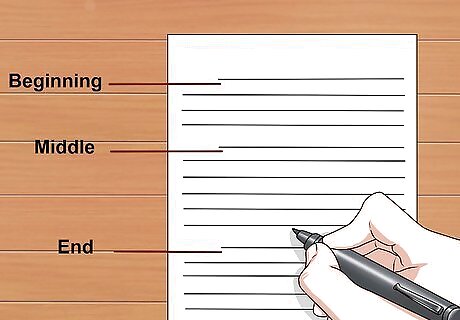
Write down an outline. A basic outline will take the beginning, middle and end that you thought up during the plot creation, giving them more sense and structure. At this point, you should be putting all of your best ideas down on paper; you can't ensure they won't slip away if you don't give them some concrete form. Don't worry about the outline making sense to anyone but yourself. Most importantly, don't skim over the outlining process. It may not be as glamorous as the actual writing itself, but it will save you frustration down the road. A strong plan results in a strong execution. Populate your outline with characters or ideas. With the basics down pat, you should see about opening up some of them. Fiction relies heavily on characters, so making separate outlines for each of your characters and how they evolve throughout the story can be helpful.
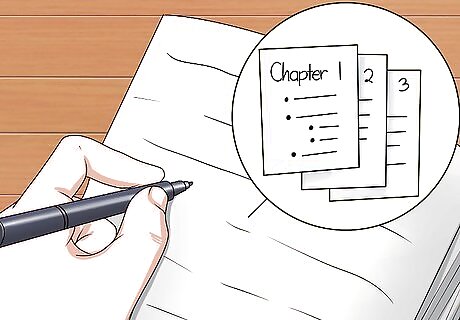
Outline chapters for your book. When tackling something as potentially daunting as an entire book, a clever way of making the process feel more manageable is to break it down into parts. If you already have an outline of the events or ideas you'd like to cover in your book, it becomes a simpler thing to break those up into bite-sized chunks you think will be more helpful to yourself and the reader. If you find yourself struggling on deciding what will populate each chapter, you should return and add new detail to your framework. Try to give each chapter a title and a couple of lines detailing what will be inside of it. You don't have to use the chapter names in your finished product; they're simply there to give you a guideline on where to go when you're writing the final thing.

Write a rough draft. By this stage, you should have a well-realized outline that leaves very little room to question where your book is heading. At last, it's finally come time to give some weight to your ideas. However, your first attempt at a written work should be considered another outline in of itself. Try to write as freely as you can; don't censor yourself at all. Take each chapter on independently and write until you feel you've covered the points in sufficient depth. It's no worry if it seems a bit short at this point; doing your final draft will see a lot of these ideas expanded or changed altogether.

Tackle the final draft. Writing, whether as a profession or a hobby, is a majority part planning. If you've followed the steps so far, you'll probably agree. In any case, it's at this point where you should hunker down to write the finished product. It may take days, weeks or months, but enough hours invested will eventually see your literary dream take solid form. It's a good idea to give a set amount of time each day to work on it. Don't let yourself lose focus of what you want to do. A final draft is considered a macro edit, but you should give the finished copy another set of revisions after reading through it.

Think of a creative title. Some people will know the name of their books before they write the first word. In other cases, the title may be the last thing you add. A really great title will pull a potential reader, without them knowing the slightest other thing about it. Think of great book titles like Ayn Rand's Atlas Shrugged, or Tolkien's The Hobbit-- these are titles that stick in someone's head, regardless if they've actually read the book before. Be patient, and try to think of an economical, pithy way of summarizing your book in a few words or less. Choose out a few words from inside your manuscript if you're having trouble. It's possible you've already written the title to your work in passing but didn't think at the time to point it out as such.
Making the Physical Copy

Create a title page. The preferred style of title page depends on the type of book you're making.. If you intend on sending your book to a publishing house, the title page should be kept relatively basic. Make a title page that offers hint of what your book is about. Stick to the basics of work title, name, date and contact info, all written in large enough font to be read easily at arms' length. With a creative venture however, the possibilities are endless. If you're visually artistic, drawing up a doodle to go with the title adds a sense of style. A title is obviously mandatory for any title page. No matter how adventurous you're getting with the title page design, make sure to make your title big and bold.
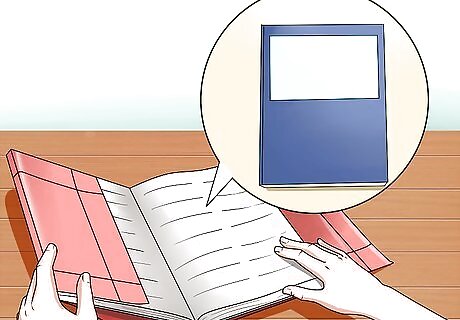
Create a cover sleeve. Most of your favourite books-- from the pulpy fantasy fiction to the leatherbound classics-- probably have an attractive cover to them. While the common adage tells us not to judge a book by its cover, there isn't a book out there that hasn't been helped out if it's got an attractive look to boot. A sleeve should wrap around both sides of your book. If you're measuring out a sleeve yourself, consider the area of the book's spine as well. For making a book at home, you should laminate a paper of your choice. Draw an appealing cover onto the sleeve if you have the artistic gusto for it, and don't forget to include important details like your name and the title of the book. Keep in mind that cover sleeves are only really worthwhile if you're doing a fully DIY approach and aren't trying to send it over to a publishing house. If your book is published professionally, the publisher will look after things like cover sleeve and artwork.
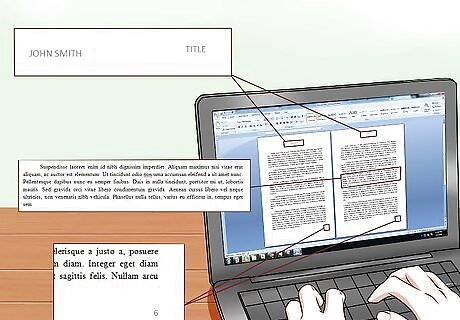
Format the manuscript. Publishers come across a load of submissions every day. While some publishing houses may not have set requirements for the formatting of your manuscript, it is generally understood that the best looking submissions stand the best chance of acceptance. A poorly presented draft may be overlooked completely... even if the material itself is brilliant! Adhere to standard font and size. Times New Roman in Size 12 is usually seen as the go-to format for text. Many professional writers prefer it because it's so easy to read. Number your pages. Page numbering cannot be overrated when you're sending a manuscript. In case the pages are dishevelled, someone on the receiving end of your literary masterpiece is going to need to know which pages fit next to which. A page heading (with author and title) doesn't hurt either. Align and indent. Microsoft Word processors will align left and properly indent your pages by default, but in case you've dabbled with the settings at all, it's a good idea to make sure this is all in order before you print.
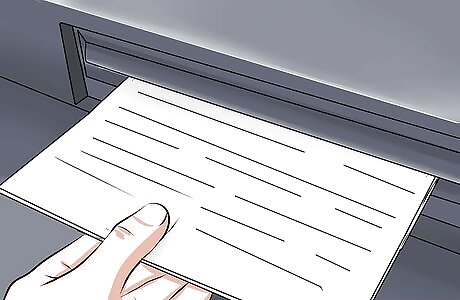
Print it off. Lastly, printing your masterpiece off is simple but essential to the plan, provided you've been doing any part of the project on a computer. Making sure that your ink cartridges are sufficient is a must, as people will become quickly aware as to the cause if the font starts getting faint by the book's end. If you lack sufficient printing equipment at home, local schools, libraries and internet cafes should be able to help you relatively inexpensively. If you're sending the manuscript somewhere professional, it may not hurt to print using a slightly off-white type of paper; this way, you'll stand out amidst the sea of generic manuscripts.

Bind your package together. If you are making a DIY book, binding a book together may be in the cards. There are many ways to go about it; if you're interested in arts and crafts, construction paper and glue are your friends. Find cardboard to glue onto the back ends of your pages as a spine, and tape your laminated cover sleeve around the book binding. Manuscripts for novels or non-fiction works that you intend on having published should not come with anything like this. Coil-binding the pages together with a basic title page will be enough. Anything too fancy or colourful in the package will detract from the potential seriousness of your work.
Getting Your Work Out There

Enjoy your book. It is surprising how many writers will try to get their work out there without first enjoying it for themselves. Though you've probably become all-too familiar with the characters and developments of your story via the editing process, there's a real charm in being able to relax and digest it for the first time as a consumer. If you've made it this far, you deserve the break.

Show it to friends. Friends can be great critics and editors; they'll take extra care to give your work the gloss it deserves, and they'll also hopefully be interested in helping you achieve your dreams. Give a copy of your manuscript to a few friends and get them to tell you what they think. Consider their edits, and give your manuscript a touch up if you deem it worthwhile.

Submit your manuscript to publishers. Find the publishers you're interested on sending your work to, and contact them about your work. Whether through email or as a physical package, get your manuscript to them. Most publishing houses vastly prefer to receive submissions as well-manicured manuscripts. It's best to send them off to as many publishing houses as possible; even the ones you're not so keen on will offer you their own chances of making you big. Publishing houses navigate through a huge array of submissions, so don't let yourself get too down if it takes them a while to get back to you.

Self-publish your novel. In the internet age, it's perfectly acceptable (and in some cases even preferable) to strike out on your own and self-publish your work online. Formatting your finished manuscript as a PDF and letting it loose on the internet is a possible way of getting your name out there. Sites like Amazon will offer you merchant opportunities for vending your finished ebook. Keep in mind, however, that you'll need to promote your book entirely on your own. If you're lucky, the novel will gain popularity through word-of-mouth, but you'll need to rely on yourself first and foremost if you plan on having success.




















Comments
0 comment